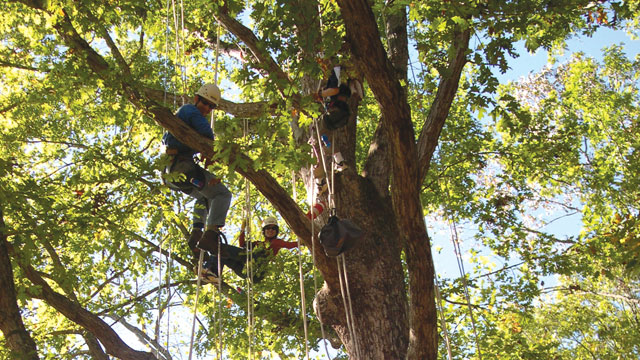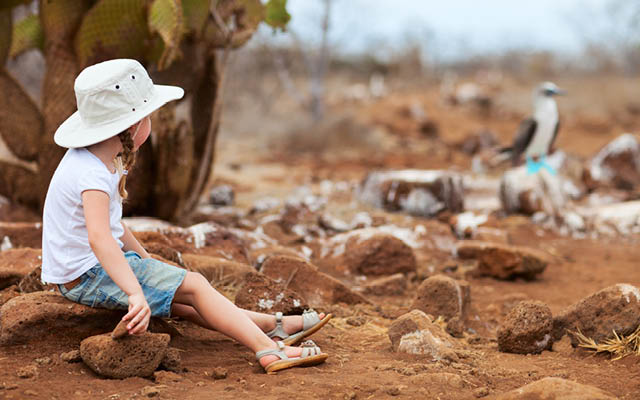Even though it’s an early-spring afternoon in northern Vermont, the state’s famous maple trees have yet to unfurl their bright green leaves. I should know: I’m standing face to face with a thick, bark-covered trunk, some 20 feet off the ground. Why am I thinking about foliage when, in a few minutes, I’m going to push myself off this platform and careen along a cable to the next tree?
Yes, I am nervous. A few years ago, I signed up for a canopy tour in Costa Rica and freaked when I got terrible vertigo from the climb into the rainforest. Back home in Vermont, I’ve decided to give the experience another go at ArborTrek Canopy Adventures, which offers a newly unveiled series of zip lines near the ski area of Smugglers’ Notch.
As I step off a platform that’s bolted to a maple tree, I hear the whoosh of the zip line and feel the air beneath my feet. I feel weightless, unbounded by gravity, and as free as I’ve ever been. Despite my earlier fears, I can’t wait to try each of the zip lines, which range in length from 175 to 1,000 feet at a maximum height of 73 feet off the forest floor. We also get to walk across two suspension bridges and rappel down two of the trees.
I’m hardly alone in taking this leap. In the last few years, canopy tours have begun to sprout up across North America in significant numbers, offering participants a bird’s-eye view of the natural environment, along with a potential trip outside the comfort zone.
According to Michael R. Smith, moderator of Zipline Nirvana and owner of Vermont’s first zip-line canopy tour, there are now some 350 large-scale, commercial zip-line tours, zip rides, and adventure parks that include zip lines in North America, which serve between 5,000 and 40,000 guests a year.
That’s as many as 2.8 million people swinging through the treetops in an activity that has seen a growth rate of 35 to 40 percent annually since 2009.
“Vacationers are looking for something more than a lake and some fishing,” says Smith. “Families aren’t spending as much time together, so this is a way to have a structured, novel experience that is highly memorable — something to talk about for years.”
“Canopy tours are surging in popularity,” concurs Paul Wolf, an outdoor leadership program coordinator at Southwestern Community College in Sylva, N.C. “It’s a much more active form of learning. There’s adventure involved, and risk. It heightens people’s awareness. You get to see things in a whole different light.”
Just ask anyone who’s tried it. “The smell of the forest is so different above rather than on the ground below — there is a clean crispness,” says Deborah Myers, a 59-year-old alternative health practitioner from Santa Rosa, Calif., who recently zip lined among ancient coastal California redwoods on Sonoma Canopy Tours. “And the sounds are magical — the quiet of the forest is intense and noticeable. Even the calls of the birds to each other seem different when you’re in the air with them.”
Zip Lines in History
Well before they were used for recreation, zip lines were deployed out of necessity. For hundreds of years, in the absence of bridges, mountainside communities attached pulleys or trolleys to cables to transport people and goods across gorges and waterways. Also known as a Tyrolean traverse, the zip line became popular among mountaineers moving from peak to peak, and then among biologists studying the South American rainforest.
Today, quality canopy tours exist across the continent, from the California wine country to the tropical rivers of Florida. At Canada’s Ziptrek Ecotours in Whistler, British Columbia, you can whoosh through the snow-covered pine trees in winter — and you can go at night, wearing a headlamp.
What if it rains, or snows, or plunges to 20 below? Canopy-tour guides can help people off the course (though it’s a rarity), but it’s part of the disclosure that they go on despite weather. “Even when the weather’s really crummy, there are huge smiles on everyone’s faces,” says Smith. And because zip lines are often located in resort areas, there’s usually the chance to warm up by a fireplace or in the spa of a first-class hotel.
What to Expect
In Vermont, my adventure begins by suiting up in harness and helmet (required on all tours) and attending a brief session of “ground school.” Here ArborTrek instructor Nate Vince shows us how to step off a platform, glide along a cable and control our speed — all on a test line that’s just a couple of feet off the ground.
While braking systems vary, depending on speeds and the steepness of the lines, this one involves gently resting my gloved hand on the cable just behind the trolley — a piece of cake.
After a brief bus ride up to the top of the course, we walk onto the first platform, no climbing required. Most North American canopy tours operate on this “gravity-fed” model, the result being that almost everyone can participate. “These are meant to be accessible experiences,” explains Wolf. “Even those who don’t like heights can ease into the situation.” Because of their size, small children can be an exception; tours typically have weight and age limits.
While those truly petrified of heights should probably avoid zip lines, for others the excitement of the experience often eclipses anxieties, offering a good opportunity to gain confidence. “Even though I can be nervous about heights, I was thrilled,” recalls Myers of her redwood tour. “I was so pumped about the day that I didn’t give myself a chance to be nervous.” Others find adventuring with family and friends is enough to alleviate pre-tour anxiety.
Tour speeds do vary, so nervous riders can start slow. The Sonoma tour, for instance, sends riders on modest speeds of up to 25 miles an hour. Meanwhile, adventure seekers will appreciate the zip lines that reach above highway speeds, up to 90 mph. These slow down over the course of hundreds of feet to stop safely at the platform, but it can be a wild ride.
If one type of tour doesn’t suit everyone in your group, most are located in prime spots for a variety of additional fun, from white-water rafting to epicurean dining. On the 5.5-hour Soaring Tree Top Adventures Canopy Tour in Durango, Colo., guests experience more than 27 zip lines, as well as a luxury train ride to the launch point and a four-course gourmet lunch along the Animas River.
Environmental Awareness
Inspired in part by rainforest canopy tours that bring participants face to face with tropical flora and fauna, many North American zip lines promote the eco-friendly aspect of their tours. Some companies make environmental awareness a key part of their mission, like Sonoma Canopy Tours. It operates as part of Alliance Redwoods, a nonprofit that promotes environmental education.
Not all environmentalists are convinced. Many argue that attaching bolts and platforms to trees, no matter how minimal the impact, isn’t an environmentally responsible way to educate. And plenty of participants enjoy the thrills of zip lining without studying their natural surroundings.
But when I step out of my harness, I realize I’ve learned about much more than my ability to conquer heights. I’ve gained lessons in my state’s eco-system, in the waterways, birds and trees I once took for granted. I can see how maples give us more than pancake syrup by protecting habitats for porcupine and possum.
“Experiencing nature up close can help many canopy tourists discover and value our natural heritage,” says ecologist Elizabeth Byers of the West Virginia Division of Natural Resources. She recalls a memorable visit to Nelson Rocks Outdoor Center in Circleville, W.Va., where she climbed a via ferrata near the canopy tour. “It was an amazing way to see an extremely fragile, beautiful cliff environment up close, without unduly damaging it,” she says. “There were rare and sensitive plants growing literally 18 inches from the climbing route, quite undisturbed by the many people climbing past them and admiring them from the secure but short length of the safety lanyards.”
Whether it’s overcoming a fear of heights, bonding with loved ones, learning about the environment or simply shedding stress in the treetops, zip-line canopy tours leave vivid impressions. “Zip lining is just plain fun,” says Kellee Waddell of the Nelson Rocks Outdoor Center. “It makes me feel like a kid again to be hollering as I’m flying through the forest!”
Canopy Tours to Try
Adventure America Zipline Canopy Tours: Choose from six different courses throughout the Southeast, including the Nantahala Gorge, Chattooga Ridge and Ocoee River Basin (not all are open every season). ww.adventureamericaziplinecanopytours.com; 866-699-2402.
ArborTrek Canopy Adventures, Smugglers’ Notch, Vermont: Open April through November for ages 8 and up, this three-hour tour (nicknamed Arbor’s Wild Ride) features eight zip lines and two suspension bridges across a course of more than 4,500 feet. www.arbortrek.com; 802-644-9300.
North Fork Valley Canopy Tour, Circleville, West Virginia: This four-hour experience includes 12 zip lines and three suspension bridges at the Nelson Rocks Outdoor Center (open on select days year-round). www.nelsonrocks.org; 877-435-4842.
Soaring Tree Top Adventures, Durango, Colo.: Claiming to be the world’s longest zip-line tour, this spot in the San Juan Mountains is reached only by train and has more than 27 spans among old-growth Ponderosa pines. www.soaringcolorado.com; 970-769-2357.
Sonoma Canopy Tours, Occidental, Calif.: Seven zip lines, a spiral staircase and two suspension bridges bring guests closer to coastal redwoods. www.sonomacanopytours.com; 888-494-7868.
Ziptrek Ecotours, Whistler, British Columbia: Participants can plunge into the rainforest summer or winter, day or night, on 2.5- to 4.5-hour tours that include up to 10 zip lines, suspension bridges and boardwalks. www.ziptrek.com; 866-935-0001.
Adventure Park, Miramar, Costa Rica: Cross 11 waterfalls on this canopy tour, which features more than 20 zip lines. www.adventureparkcostarica.com; 800-953-8262.|
Add More Zip to Your Trip
Because canopy tours are typically found in forested natural areas, there is often a slew of other outdoor activities nearby, such as:
- Via ferrata (a fixed cable and ladder route up the side of a mountain)
- Horseback riding
- Downhill skiing and snowboarding
- Rock climbing
- Mountain biking
- White-water rafting
- Hiking
- Swimming in hot springs
- Cross-country skiing
- Ropes course
- ATV and Jeep tours



This Post Has 0 Comments